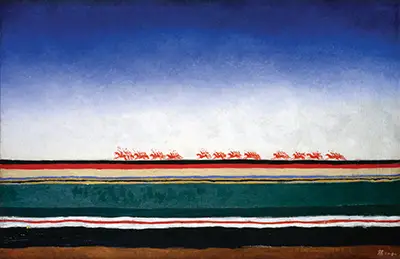Kazimir Malevich's Red Cavalry Riding is as much a political piece as it is a reflection of history. The painting is currently hanging in the State Russian Museum and several visitors like gazing at it in particular.
Malevich was Russian and the rangers portrayed presumably allude to the Russian Red Army. The artist was at the forefront of the Communist development in Russia. He was one of the early comrade optimists and when Stalin came to power, he was severely aggrieved.
Nobody truly comprehends what Malevich considered Stalinist Russia to be, yet his sketches from this period tend to venture into the realm of depression. There is distance in each one of the compositions he created during this time and viewers get a sense of far off elements that are too remote to reach.
At the point when Stalin committed the deadly cleanses of senior officers of the Red Army in the late 1930's, he saved a large number of the individuals who had battled with him in the First Cavalry. That is the reason why some generals, for example, Voroshilov and Zhukov survived while others were killed.
The Red Army portrayed in Kazimir Malevich's painting was started when Semyon Budyonny, a radicalized WW1 legend and Cossack pioneer, sorted out a mounted force referred to at first as the Red Cavalry in the Don area. This Red Cavalry in the end was formed into the First Cavalry Army. The disciplined approach that the Red Army had may be represented in part by the comparative inflexibility of the riders in the painting.
Separated from its infamous pioneer, the mounted group had another name that would develop a distinctly different reputation. The Red Cavalry or First Cavalry Army demonstrated a surprisingly successful approach to fighting. As a unit it was immensely likely to do well in any battle. Its front line triumphs contributed enormously to winning the Civil War for the Bolsheviks and it pushed the White fighters far from the Russian capital.
Kazimir Malevich's had his own feelings about the Red Army and in Red Cavalry Riding, it seems that he is trying to gain some perspective. The riders are not seen up close. Instead, they are viewed from a distance, as though the artist does not want to get too involved. The setting is not one of war and instead, the painting shows them quietly riding, possibly en route to a battle or coming from one.
The undeniable comparison some observers make is to the painting Red House, dating from around a similar time. Red House is a simple painting, which uses horizontal stripes to divide up the world portrayed in the picture, forcing us to look at it head on. Malevich utilises a similar kind of quiet shading plan in his structure for Red Cavalry Riding. There is a huge and seemingly perpetual sky over the riders which appears to extend as far as possible up to space.
While many people focus on the history of the riders and their part in war, it is important to note that the artist has brought the beauty of the landscape into play. In fact, this focuses on the relationship between the riders and horses as well. From the separated lines of shading, you can get a sense for the droning of the hooves as the mounted force rides over the tundra. This picture could move architects to emphasise colourful lines and use intriguing hues to bring a specific mood to their work.
While viewers may not be certain what the importance of the striped forefront is, it is certainly not exclusive to Red Cavalry Riding. In fact, the striped forefront is something that shows up in the majority of his late pieces. To the extent that the rangers' figures are depersonalised, viewers could presumably draw some kind of correlation with Malevich's geometric pieces like Suprematism with Eight Red Triangles.
A great deal of Malevich's late paintings have some kind of combination of his prior work with geometric shapes. The rangers appear to be dauntless and steady in their course. It may even seem that they form a line of force that will he difficult for any aggressor to contend with.
They seem determined not to have their advance hindered. Malevich may not get into too much detail when it comes to portraying them as individuals or seeking to find what inspires them but his work is mostly complimentary. As far as fighters go, discipline is an important asset. These riders are certainly shown to have a lot of that.
The Red Cavalry was painted using oil on canvas. Its current place in the Russian State Museum in St. Petersburg is appropriate and will lend context to art lovers who also view it as a portrayal of an important part of Russian history.




